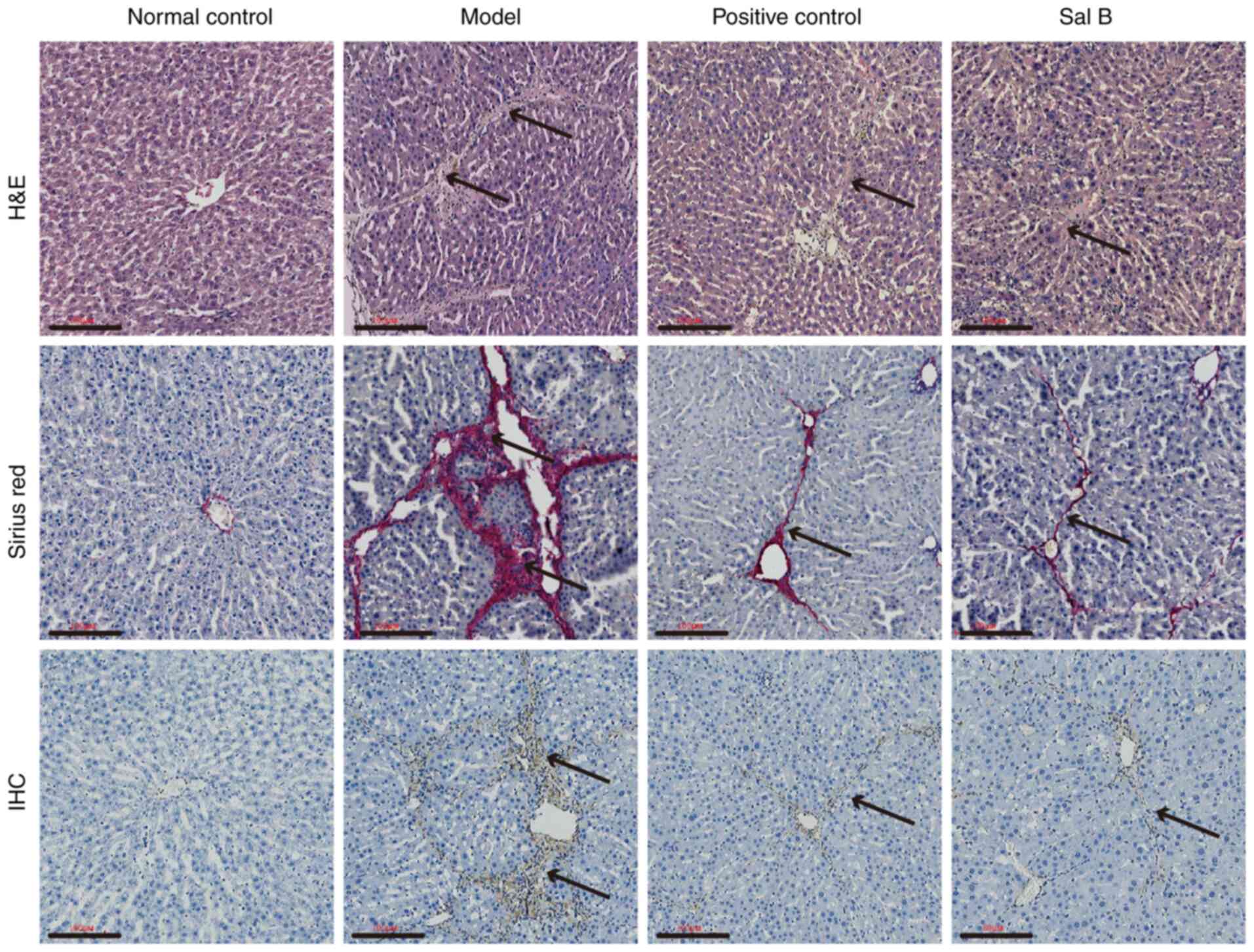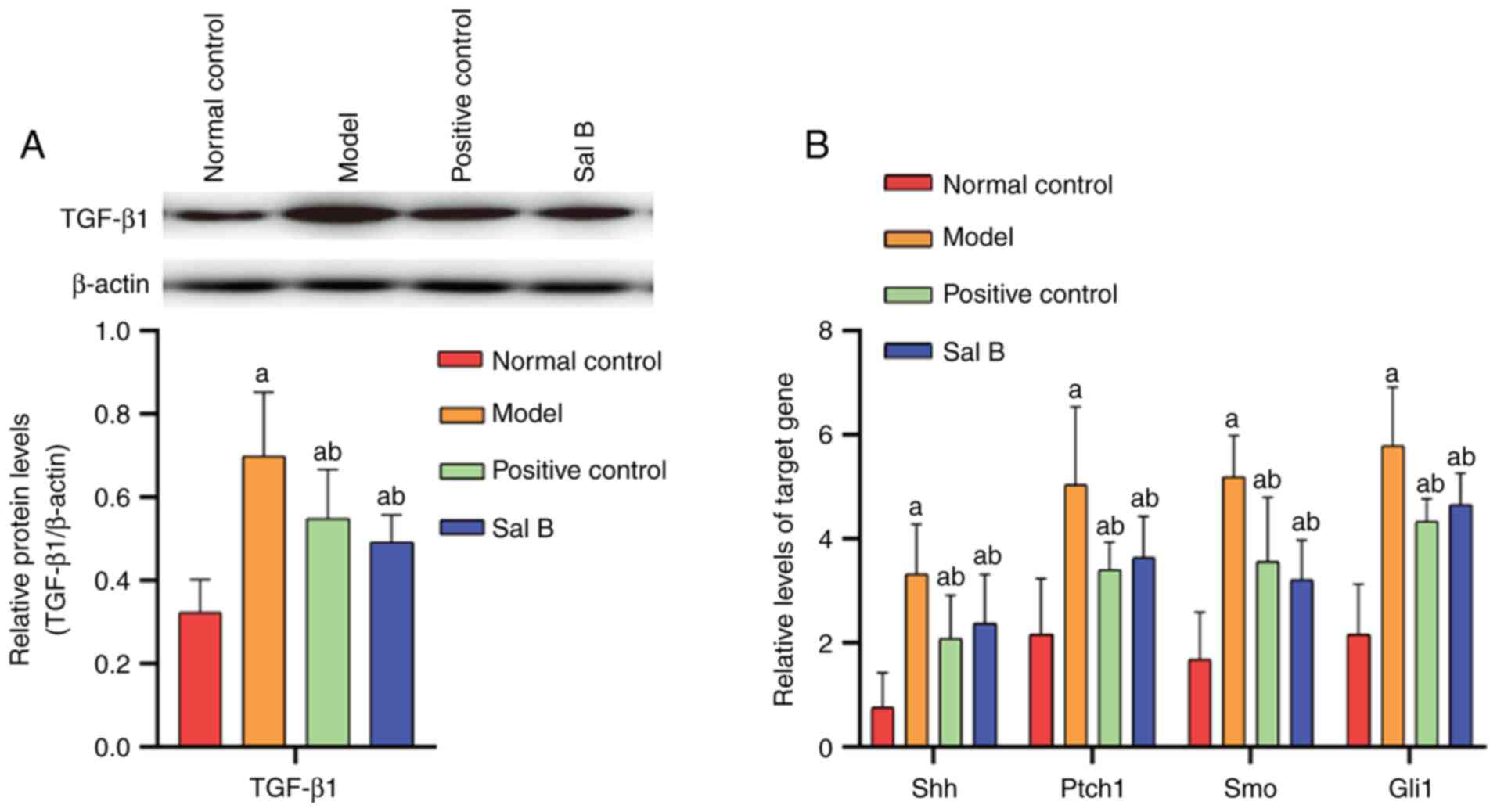|
1
|
Bellan M, Castello LM and Pirisi M:
Candidate biomarkers of liver fibrosis: A concise,
pathophysiology-oriented review. J Clin Transl Hepatol. 6:317–325.
2018.PubMed/NCBI View Article : Google Scholar
|
|
2
|
Wan SZ, Liu C, Huang CK, Luo FY and Zhu X:
Ursolic acid improves intestinal damage and bacterial dysbiosis in
liver fibrosis mice. Front Pharmacol. 10(1321)2019.PubMed/NCBI View Article : Google Scholar
|
|
3
|
Atta HM: Reversibility and heritability of
liver fibrosis: Implications for research and therapy. World J
Gastroenterol. 21:5138–5148. 2015.PubMed/NCBI View Article : Google Scholar
|
|
4
|
Trautwein C, Friedman SL, Schuppan D and
Pinzani M: Hepatic fibrosis: Concept to treatment. J Hepatol. 62
(Suppl 1):S15–S24. 2015.PubMed/NCBI View Article : Google Scholar
|
|
5
|
Elpek GO: Cellular and molecular
mechanisms in the pathogenesis of liver fibrosis: An update. World
J Gastroenterol. 20:7260–7276. 2014.PubMed/NCBI View Article : Google Scholar
|
|
6
|
Phaosri M, Jantrapirom S, Takuathung MN,
Soonthornchareonnon N, Sireeratawong S, Buacheen P, Pitchakarn P,
Nimlamool W and Potikanond S: Salacia chinensis L. stem
extract exerts antifibrotic effects on human hepatic stellate cells
through the inhibition of the TGF-β1-induced SMAD2/3 signaling
pathway. Int J Mol Sci. 20(6314)2019.PubMed/NCBI View Article : Google Scholar
|
|
7
|
Gandhi CR: Hepatic stellate cell
activation and pro-fibrogenic signals. J Hepatol. 67:1104–1105.
2017.PubMed/NCBI View Article : Google Scholar
|
|
8
|
Singh R and Lauth M: Emerging roles of
DYRK kinases in embryogenesis and hedgehog pathway control. J Dev
Biol. 5(13)2017.PubMed/NCBI View Article : Google Scholar
|
|
9
|
Abramyan J: Hedgehog signaling and
embryonic craniofacial disorders. J Dev Biol. 7(9)2019.PubMed/NCBI View Article : Google Scholar
|
|
10
|
Michelotti GA, Xie G, Swiderska M, Choi
SS, Karaca G, Krüger L, Premont R, Yang L, Syn WK, Metzger D and
Diehl AM: Smoothened is a master regulator of adult liver repair. J
Clin Invest. 123:2380–2394. 2013.PubMed/NCBI View
Article : Google Scholar
|
|
11
|
Zheng Z, Wang Y, Yu H, Li W, Wu J, Cai C
and He Y: Salvianolic acid B inhibits ototoxic drug-induced
ototoxicity by suppression of the mitochondrial apoptosis pathway.
J Cell Mol Med. 24:6883–6897. 2020.PubMed/NCBI View Article : Google Scholar
|
|
12
|
Ren Y, Tao S, Zheng S, Zhao M, Zhu Y, Yang
J and Wu Y: Salvianolic acid B improves vascular endothelial
function in diabetic rats with blood glucose fluctuations via
suppression of endothelial cell apoptosis. Eur J Pharmacol.
791:308–315. 2016.PubMed/NCBI View Article : Google Scholar
|
|
13
|
Lu XL, Dong XY, Fu YB, Cai JT, Du Q, Si JM
and Mao JS: Protective effect of salvianolic acid B on chronic
pancreatitis induced by trinitrobenzene sulfonic acid solution in
rats. Pancreas. 38:71–77. 2009.PubMed/NCBI View Article : Google Scholar
|
|
14
|
Zhang W, Ping J, Zhou Y, Chen G and Xu L:
Salvianolic acid B inhibits activation of human primary Hepatic
stellate cells through downregulation of the myocyte enhancer
factor 2 signaling pathway. Front Pharmacol. 10(322)2019.PubMed/NCBI View Article : Google Scholar
|
|
15
|
Yu F, Lu Z, Chen B, Wu X, Dong P and Zheng
J: Salvianolic acid B-induced microRNA-152 inhibits liver fibrosis
by attenuating DNMT1-mediated Patched1 methylation. J Cell Mol Med.
19:2617–2632. 2015.PubMed/NCBI View Article : Google Scholar
|
|
16
|
Kim S, Jung ES, Lee J, Heo NJ, Na KY and
Han JS: Effects of colchicine on renal fibrosis and apoptosis in
obstructed kidneys. Korean J Intern Med. 33:568–576.
2018.PubMed/NCBI View Article : Google Scholar
|
|
17
|
Liu H, Liu W, Qiu H, Zou D, Cai H, Chen Q,
Zheng C and Xu D: Salvianolic acid B protects against myocardial
ischaemia-reperfusion injury in rats via inhibiting high mobility
group box 1 protein expression through the PI3K/Akt signalling
pathway. Naunyn Schmiedebergs Arch Pharmacol. 393:1527–1539.
2020.PubMed/NCBI View Article : Google Scholar
|
|
18
|
Livak KJ and Schmittgen TD: Analysis of
relative gene expression data using real-time quantitative PCR and
the 2(-Delta Delta C(T)) Method. Methods. 25:402–408.
2001.PubMed/NCBI View Article : Google Scholar
|
|
19
|
Sun M and Kisseleva T: Reversibility of
liver fibrosis. Clin Res Hepatol Gastroenterol. 39 (Suppl
1):S60–S63. 2015.PubMed/NCBI View Article : Google Scholar
|
|
20
|
Bansal R, Nagorniewicz B and Prakash J:
Clinical advancements in the targeted therapies against liver
fibrosis. Mediators Inflamm. 2016(7629724)2016.PubMed/NCBI View Article : Google Scholar
|
|
21
|
Josan S, Billingsley K, Orduna J, Park JM,
Luong R, Yu L, Hurd R, Pfefferbaum A, Spielman D and Mayer D:
Assessing inflammatory liver injury in an acute CCl4 model using
dynamic 3D metabolic imaging of hyperpolarized [1-(13)C]pyruvate.
NMR Biomed. 28:1671–1677. 2015.PubMed/NCBI View
Article : Google Scholar
|
|
22
|
Cheresh P, Kim SJ, Tulasiram S and Kamp
DW: Oxidative stress and pulmonary fibrosis. Biochim Biophys Acta.
1832:1028–1040. 2013.PubMed/NCBI View Article : Google Scholar
|
|
23
|
Echeverría F, Valenzuela R, Bustamante A,
Álvarez D, Ortiz M, Espinosa A, Illesca P, Gonzalez-Mañan D and
Videla LA: High-fat diet induces mouse liver steatosis with a
concomitant decline in energy metabolism: Attenuation by
eicosapentaenoic acid (EPA) or hydroxytyrosol (HT) supplementation
and the additive effects upon EPA and HT co-administration. Food
Funct. 10:6170–6183. 2019.PubMed/NCBI View Article : Google Scholar
|
|
24
|
Ortiz M, Soto-Alarcón SA, Orellana P,
Espinosa A, Campos C, López-Arana S, Rincón MA, Illesca P,
Valenzuela R and Videla LA: Suppression of high-fat diet-induced
obesity-associated liver mitochondrial dysfunction by
docosahexaenoic acid and hydroxytyrosol co-administration. Dig
Liver Dis. 52:895–904. 2020.PubMed/NCBI View Article : Google Scholar
|
|
25
|
Valenzuela R and Videla LA: Impact of the
Co-Administration of N-3 fatty acids and olive oil components in
preclinical nonalcoholic fatty liver disease models: A mechanistic
view. Nutrients. 12(499)2020.PubMed/NCBI View Article : Google Scholar
|
|
26
|
Ni YH, Huo LJ and Li TT: Antioxidant axis
Nrf2-keap1-ARE in inhibition of alcoholic liver fibrosis by IL-22.
World J Gastroenterol. 23:2002–2011. 2017.PubMed/NCBI View Article : Google Scholar
|
|
27
|
Valenzuela R and Videla LA: Crosstalk
mechanisms in hepatoprotection: Thyroid hormone-docosahexaenoic
acid (DHA) and DHA-extra virgin olive oil combined protocols.
Pharmacol Res. 132:168–175. 2018.PubMed/NCBI View Article : Google Scholar
|
|
28
|
Liang JX, Qu XF, Zeng WT, Zhu KL, Zhang H
and Wei JJ: Mechanism of oxymatrine in preventing hepatic fibrosis
formation in patients with chronic hepatitis B. Nan Fang Yi Ke Da
Xue Xue Bao. 30:1871–1873. 2010.PubMed/NCBI(In Chinese).
|
|
29
|
Seki E and Brenner DA: Recent advancement
of molecular mechanisms of liver fibrosis. J Hepatobiliary Pancreat
Sci. 22:512–518. 2015.PubMed/NCBI View
Article : Google Scholar
|
|
30
|
Li D, He L, Guo H, Chen H and Shan H:
Targeting activated hepatic stellate cells (aHSCs) for liver
fibrosis imaging. EJNMMI Res. 5(71)2015.PubMed/NCBI View Article : Google Scholar
|
|
31
|
Wang YC, Kong WZ, Jin QM, Chen J and Dong
L: Effects of salvianolic acid B on liver mitochondria of rats with
nonalcoholic steatohepatitis. World J Gastroenterol.
21:10104–10112. 2015.PubMed/NCBI View Article : Google Scholar
|
|
32
|
Wang R, Yu XY, Guo ZY, Wang YJ, Wu Y and
Yuan YF: Inhibitory effects of salvianolic acid B on CCl(4)-induced
hepatic fibrosis through regulating NF-κB/IκBα signaling. J
Ethnopharmacol. 144:592–598. 2012.PubMed/NCBI View Article : Google Scholar
|
|
33
|
Skoda AM, Simovic D, Karin V, Kardum V,
Vranic S and Serman L: The role of the Hedgehog signaling pathway
in cancer: A comprehensive review. Bosn J Basic Med Sci. 18:8–20.
2018.PubMed/NCBI View Article : Google Scholar
|
|
34
|
Kumar V, Dong Y, Kumar V, Almawash S and
Mahato RI: The use of micelles to deliver potential hedgehog
pathway inhibitor for the treatment of liver fibrosis.
Theranostics. 9:7537–7555. 2019.PubMed/NCBI View Article : Google Scholar
|
|
35
|
Gao L, Zhang Z, Zhang P, Yu M and Yang T:
Role of canonical Hedgehog signaling pathway in liver. Int J Biol
Sci. 14:1636–1644. 2018.PubMed/NCBI View Article : Google Scholar
|
|
36
|
Ghafoory S, Varshney R, Robison T,
Kouzbari K, Woolington S, Murphy B, Xia L and Ahamed J: Platelet
TGF-β1 deficiency decreases liver fibrosis in a mouse model of
liver injury. Blood Adv. 2:470–480. 2018.PubMed/NCBI View Article : Google Scholar
|
|
37
|
El-Agroudy NN, El-Naga RN, El-Razeq RA and
El-Demerdash E: Forskolin, a hedgehog signalling inhibitor,
attenuates carbon tetrachloride-induced liver fibrosis in rats. Br
J Pharmacol. 173:3248–3260. 2016.PubMed/NCBI View Article : Google Scholar
|
















